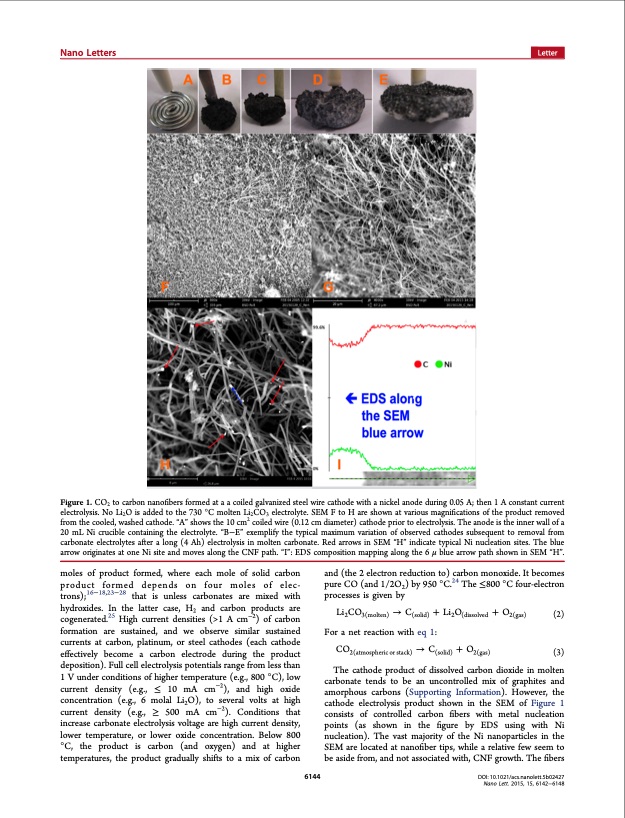
PDF Publication Title:
Text from PDF Page: 003
Nano Letters Letter Figure 1. CO2 to carbon nanofibers formed at a a coiled galvanized steel wire cathode with a nickel anode during 0.05 A; then 1 A constant current electrolysis. No Li2O is added to the 730 °C molten Li2CO3 electrolyte. SEM F to H are shown at various magnifications of the product removed from the cooled, washed cathode. “A” shows the 10 cm2 coiled wire (0.12 cm diameter) cathode prior to electrolysis. The anode is the inner wall of a 20 mL Ni crucible containing the electrolyte. “B−E” exemplify the typical maximum variation of observed cathodes subsequent to removal from carbonate electrolytes after a long (4 Ah) electrolysis in molten carbonate. Red arrows in SEM “H” indicate typical Ni nucleation sites. The blue arrow originates at one Ni site and moves along the CNF path. “I”: EDS composition mapping along the 6 μ blue arrow path shown in SEM “H”. moles of product formed, where each mole of solid carbon product formed depends on four moles of elec- trons);16−18,23−28 that is unless carbonates are mixed with hydroxides. In the latter case, H2 and carbon products are cogenerated.25 High current densities (>1 A cm−2) of carbon formation are sustained, and we observe similar sustained currents at carbon, platinum, or steel cathodes (each cathode effectively become a carbon electrode during the product deposition). Full cell electrolysis potentials range from less than 1 V under conditions of higher temperature (e.g., 800 °C), low current density (e.g., ≤ 10 mA cm−2), and high oxide concentration (e.g., 6 molal Li2O), to several volts at high current density (e.g., ≥ 500 mA cm−2). Conditions that increase carbonate electrolysis voltage are high current density, lower temperature, or lower oxide concentration. Below 800 °C, the product is carbon (and oxygen) and at higher temperatures, the product gradually shifts to a mix of carbon 6144 and (the 2 electron reduction to) carbon monoxide. It becomes pure CO (and 1/2O2) by 950 °C.24 The ≤800 °C four-electron processes is given by Li CO → C + Li O + O 2 3(molten) (solid) 2 (dissolved 2(gas) (2) For a net reaction with eq 1: CO2(atmospheric or stack) → C(solid) + O2(gas) (3) The cathode product of dissolved carbon dioxide in molten carbonate tends to be an uncontrolled mix of graphites and amorphous carbons (Supporting Information). However, the cathode electrolysis product shown in the SEM of Figure 1 consists of controlled carbon fibers with metal nucleation points (as shown in the figure by EDS using with Ni nucleation). The vast majority of the Ni nanoparticles in the SEM are located at nanofiber tips, while a relative few seem to be aside from, and not associated with, CNF growth. The fibers DOI: 10.1021/acs.nanolett.5b02427 Nano Lett. 2015, 15, 6142−6148PDF Image | One-Pot Synthesis of Carbon Nanofibers from CO2

PDF Search Title:
One-Pot Synthesis of Carbon Nanofibers from CO2Original File Name Searched:
acs.nanolett.5b02427.pdfDIY PDF Search: Google It | Yahoo | Bing
Sulfur Deposition on Carbon Nanofibers using Supercritical CO2 Sulfur Deposition on Carbon Nanofibers using Supercritical CO2. Gamma sulfur also known as mother of pearl sulfur and nacreous sulfur... More Info
CO2 Organic Rankine Cycle Experimenter Platform The supercritical CO2 phase change system is both a heat pump and organic rankine cycle which can be used for those purposes and as a supercritical extractor for advanced subcritical and supercritical extraction technology. Uses include producing nanoparticles, precious metal CO2 extraction, lithium battery recycling, and other applications... More Info
| CONTACT TEL: 608-238-6001 Email: greg@infinityturbine.com | RSS | AMP |